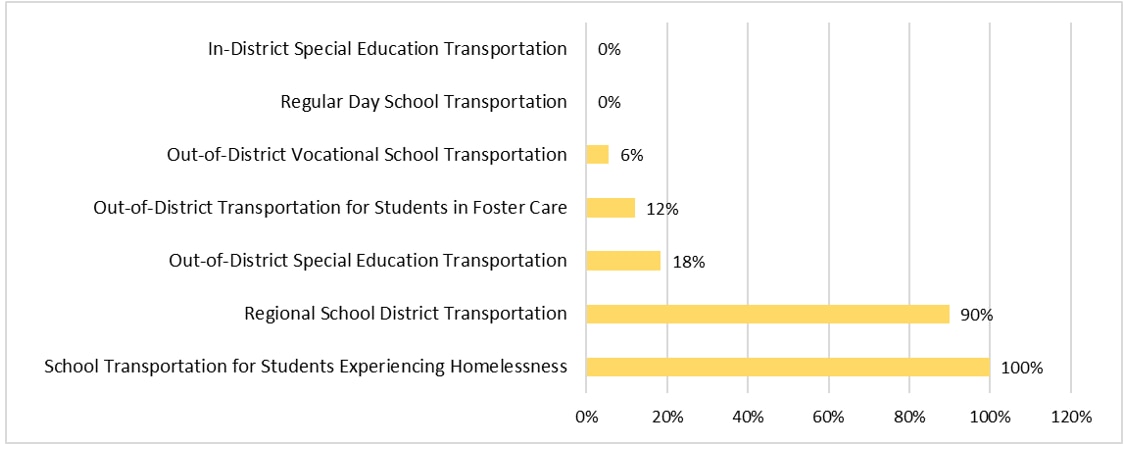Overview
School transportation expenses are traditionally recorded under multiple categories and are based on determinants such as a student’s origin district, the type of school a student is attending, and a student’s individual characteristics. As a result, there are seven reimbursement programs devoted to school transportation with wide variation among the programs’ reimbursement levels. Despite a statutory commitment, the extent that the Commonwealth finances school transportation ranges from fully funding transportation for students in families experiencing homelessness to allocating zero funding for regular day and in-district transportation of students receiving special education services. Figure 16 illustrates the funding disparities among these programs and how they are all not funded at the same level.
Figure 16—Funding Levels of School Transportation Aid Programs159
Reimbursements for school transportation are contingent on specific requirements, which have led to certain expenses not being covered by the programs. The functions shown in Figure 17 are requirements for districts to provide to students, and the threshold for reimbursement varies based on the program. For example, regional school transportation reimbursement is only for distances greater than 1.5 miles from home, although RSDs must supply transportation to all students, regardless of how far their home is from school. On the other hand, transportation for students experiencing homelessness and students in foster care must meet the requirements of specific definitions connected to federal law.
Figure 17 - Student Populations with Guaranteed School Transportation vs. Student Populations Covered by School Transportation Reimbursement
|
Transportation Reimbursement Program Name |
Student Populations with Guaranteed Transportation (under law) |
Student Populations Covered By Reimbursement |
|
Regular Day Transportation in Public School Districts |
All students in grades K-6 who live more than 2 miles from the school they are attending and live more than 1 mile from the nearest school bus stop160 |
Students who live more than 1.5 miles from the public school, even if they live in another city/town161 |
|
In-District and OOD Special Education Transportation |
All students with an IEP who take regular transportation to in-district and OOD public schools All students with an IEP who require special transportation to in-district and OOD public schools, regardless of distance, and to private schools within the geographic boundaries of the student’s home district162 |
In-District: Students with an IEP who live more than 1.5 miles from the public school, even if they live in another city/town, regardless of transportation type163 OOD: Students with an IEP who attend OOD programs and use in-house transportation or a contracted transportation provider, regardless of distance164 |
|
RSD Transportation |
All students in grades K-12, regardless of distance165 |
Students who live more than 1.5 miles from the school166 |
|
OOD Vocational-Technical School Transportation |
Students who attend independent vocational technical school districts and students who live outside of a public school district that houses a vocational technical school167 |
Students who attend vocational schools outside of their home district and live more than 1.5 miles from the school168 |
|
School Transportation for Students Experiencing Homelessness |
Students who attend schools at their district of origin that they previously went to prior to becoming homeless, at the request of a parent or guardian, if they live outside of the district’s boundaries169 |
Students who attend schools at their district of origin that they previously went to prior to becoming homeless, at the request of a parent or guardian, if they live outside of the district’s boundaries, and use transportation provided by a school district, parent-provided transportation, or public/private transportation carriers170 |
|
Foster Care Student Transportation |
Students in foster care who attend schools in their district of origin from the district they currently live in, if it is determined it is in the best interest, regardless of distance171 |
Students in foster care who attend schools in their district of origin from the district they currently live in, if it is determined it is in their best interest, regardless of distance172 |
In addition, collecting and reporting data required for reimbursement is a complex process due to the multiple reimbursement programs in existence. It is possible that a single vehicle may contain students whose expenses reflect different programs and there will be a need to report on some type of division of costs. Additionally, students who have multiple education characteristics (for example, a student who is receiving special education services but is also experiencing homelessness) are only considered for one type of reimbursement.173
Districts continue to raise concerns about the lack of competition for school transportation contracts, as well as a shortage of drivers to meet transportation needs.
